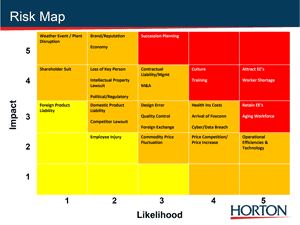By Tony Hopkins, CPCU, CIC, CRM
For the successful company of the future, growth will be looked at in a whole new light. Up until this point, companies sought to grow by focusing mainly on sales. HR is the new sales. The new bottleneck to growth is finding good talent. Recruiting is almost as important, if not more important than sales.
Understand that I’m in sales myself, so I don’t throw comments around like this very lightly. But as I analyze our client base and what’s happening across the country, this point seems to be confirmed daily. The vast majority of companies we talk to aren’t struggling to find new customers, in fact, it seems to be the opposite, many companies are struggling to keep up with the demands of their current customer base, and this is showing through on-time delivery, productivity, quality, and safety standards.
Many companies are in the “I need a warm body” mode than in an environment where they can be selective, picking only the best talent. While “filling the seat” is necessary to meet demand, it can lead to significant adverse cultural ramifications if not done correctly. The stack of applicant’s companies has to select from is key to future success. The more selective a company can be, the easier the future becomes. This point alone speaks to the importance of recruiting and the attention it deserves going forward.
The company of the future is doubling down on HR
The role of HR has never been more critical, and it is only getting more challenging due to:
- Historically low unemployment
- Aging workforce
- Succession at all levels
- Health insurance cost trend
- Compliance complexities
- Talent gap
- Training demands
- Wage inflation & competition
- Importance of culture
- All combined with a millennial generation who demands a lot out of an employer
All the reasons above are putting a lot of strain on what was likely an understaffed department, to begin with – even in the smaller organization no one person can handle all of these challenges. The HR staffing models used in the past are no longer valid, often underestimating the number of people and talent needed to execute in today’s environment. The rate of change in HR is also not slowing down anytime soon, making it even more important to get out ahead.
Role of HR is Changing
For some organizations, HR has been an after-thought, onboarding employees, handling the benefit plans, and firing underperformers.
The crucial role of the HR department of the future is a “C-Suite”/possibly board-level position, of vital importance. While the demand for strategic HR talent is prevalent, many cite a lack of supply. HR talent is not immune to the talent gap. Similar to the approach many are taking across their organization when faced with the gap, most are hiring for culture and potential, while training for what’s required. The same thing is happening in HR. Today more than ever, HR Directors are coming from financial, operations or sales backgrounds.
HR Staff Investment Analysis
Companies do not have a blank check to hire additional “overhead” in the HR department, so it’s likely that making a hire in HR, means that a hire in another department may not be possible.
To help analyze the need for your organization, we suggest asking yourself these questions and consider the answers provided by most organizations that recognize a need today for investing in HR. If your answers don’t match those provided or the thought pattern, then HR may not be the place to invest at this time.
- What is our biggest risk in today’s environment?
- Attracting and retaining the best talent
- Is skilled labor available in your hiring area?
- No, we can’t find anyone with experience which is worth hiring, we need to train from a place of almost zero experience and skill
- Does your company have enough good managers to manage underperformers?
- No, much of our mid-level management has turned over in recent years, with most in the role inexperienced at managing people
- If you’ve determined that bringing in new customers is not as challenging as meeting the demands of current customers – Compare how much is spent on sales staff + selling expenses against what is spent on recruiting/HR staff + expenses.
- While it’s been easier to justify hiring a new salesperson, as they can “pay for themselves” eventually, we spend 10 to 1 on selling vs. recruiting, despite recruiting being our biggest corporate bottleneck
Biggest Risks Most Companies Face
The #1 risk most are citing is attracting the best talent. It’s important today, more than ever to identify and prioritize the most significant risks facing your company. Attracting talent may not be #1 for you.
No decision is easy when it comes to investing in the business or trying to manage through problems, whether faced internally or impacting us all, but with a methodology to identify your key risks and prioritize the most important, decisions and strategies can then be made with far more confidence.
The most effective way to identify and prioritize risk is through “risk mapping”. See below for our manufacturing industry risk map.
This risk map is built from the feedback of our client base. This article addresses the trends we saw in this risk map, with HR issues entering the “red zone” more frequently, finally getting to the point of dominating the “red zone”.
This process is also known as Enterprise Risk Management or ERM. Enterprise risk management is the process of planning, organizing, leading, and controlling the activities of an organization to minimize the effects of risk on an organization’s capital and earnings.
In future articles, we’ll cover more on ERM and Risk Mapping, including how to start, who to involve in the process, what to do with the information and how to build a risk management plan.
HR to Grow
For as many unique ideas floating around, on how to recruit talent and build an HR department effectively; there are just as many unique cultures. Blending your unique culture with your strategy is vital to future success. However, I implore you not to use your unique culture as an excuse for why something can’t or won’t change.
We’re now at a place where change is inevitable. What likely worked five years ago, isn’t going to work in today’s environment. We can’t manage our businesses the way we used to, they just merely won’t stay in existence if we do. Those embracing change will thrive in the future. No department has a more prominent challenge ahead than human resources. With ownership level support for the HR department, there is also no greater opportunity.
Material posted on this website is for informational purposes only and does not constitute a legal opinion or medical advice. Contact your legal representative or medical professional for information specific to your legal or medical needs.





